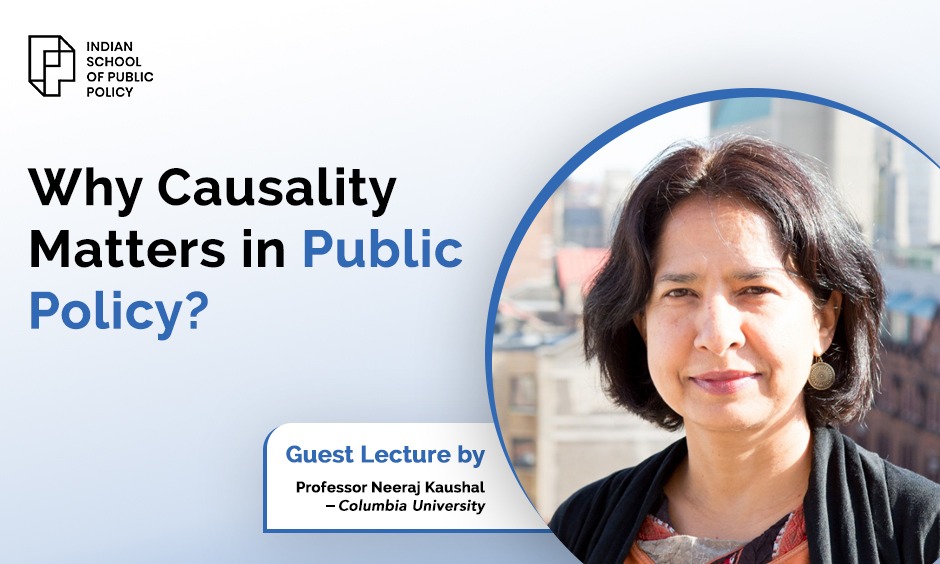Table of Contents
Why Causality Matters in Public Policy?

Reflections from a Guest Lecture by Professor Neeraj Kaushal, Columbia University
There’s a quiet revolution happening in policy circles, one that doesn’t make headlines but literally decides which policies live and which die. It’s not about budgets or political slogans. It’s about answering one simple question: Did this policy actually cause the change we had hoped for?
That pressing question was the essence of Professor Neeraj Kaushal’s lecture held on 27th October at ISPP campus. In an hour that felt like ten minutes, she walked us through the messy, but magnificent world of causal inference, the science of separating coincidence from consequence.
Professor Neeraj Kaushal is an economist and journalist by training, serving as Professor of Social Policy at Columbia University’s School of Social Work. Her research explores immigration, labor markets, and public policy across countries. She is also the author of Blaming Immigrants: Nationalism and the Economics of Global Movement (Columbia University Press, 2018).
Correlation Is a Mirage, Causality Is the Truth
She started by stating a truth that economists whisper but rarely shout: most things that look related aren’t actually related. She added, if people with health insurance live longer, is it because of the insurance or because those people were already richer, better educated, and more health-conscious? If food aid schemes and people’s insecurity about food rise together does that mean any food aid programme has failed or the hungrier, and most deprived are the ones applying for help through a food aid programme?
While correlation tells us two things move together, causality tells us why. That difference holds the entire moral weight of policymaking. As Prof. Kaushal reminded us: “If we mistake correlation for causation, we end up rewarding the wrong programme and punishing the right ones. We simply can’t afford to be fooled by numbers.”
The Counterfactual: The Ghost We Can Never See
According to Prof. Kaushal the beauty and tragedy of causal inference lie in what we’ll never observe: the counterfactual.
For every person who got a treatment (say, under a new health benefit), we can’t see what would’ve happened to them if they hadn’t been part of the benefit. For every state that implemented a big scheme, we’ll never truly see how much better or worse it would have been without that scheme.
So, economists improvise. They find comparison groups, the closest possible worlds that didn’t get the treatment. That’s the game, that’s the art. “We are constantly searching for a good statistical “twin” for our treated group,” she added.
The Quest for Causality: Experiments and Their Clever Impostors
Prof. Kaushal added, in a perfect world, we’d run Randomised Controlled Trials (RCTs) for every policy. Flip a coin, some people get the treatment, others don’t. Then compare the outcomes to establish causality.
“But real life isn’t a lab. We can’t randomly assign poverty, education, or war. That’s where economists get creative,” she added.
1. The Gold Standard: RCTs
Prof. Kaushal cited the landmark case study of the RAND Health Insurance Experiment in the 1970s. She added, it remains the North Star, a massive study that tested how different insurance plans affected health outcomes. The result? Insurance changed behavior (utilisation) but not necessarily health outcomes in a dramatic way.
Prof. Kaushal said that decades later, the Oregon Health Study tried something similar with Medicaid via a lottery system. Same story: more utilization, less financial stress, but only modest improvements in actual health. Real life rarely behaves as cleanly as theory.
2. The Real World’s Lab: Natural Experiments
Prof. Kaushal was of the view, when pure randomization isn’t possible, sometimes life steps in and does the randomization for us. These are called Natural Experiments, real-world events that mimic the logic of an RCT by introducing randomness through policy shifts, shocks, or historical accidents.
She shared the example of the COVID-19 pandemic, for instance, which hit different regions at different times and intensities, creating accidental “treatment” and “control” groups. Another instance, the September 11, 2001 terrorist attacks in the United States, offered another exogenous shock. This tragedy allowed Professor Kaushal and others to study labour-market discrimination against Arab and Muslim residents in the U.S., a rare opportunity to observe how fear, media narratives, and abrupt policy shifts ripple through employment and identity.
Economists have long relied on such moments, according to her. One of the most famous is the Mariel Boatlift of 1980, when around 125,000 Cuban refugees suddenly arrived in Miami. This unexpected migration surge created a natural experiment for studying the impact of immigration on native wages—research later led by David Card, a Canadian-born labor economist at the University of California, Berkeley. Card’s findings, which showed that the influx had little effect on local wages or employment, fundamentally reshaped debates on immigration and labor markets and ultimately earned him the 2021 Nobel Prize in Economics.
Closer home, Professor Kaushal’s work on the Sardar Sarovar Dam resettlement project used similar logic. The dam’s construction displaced and resettled tribal communities across Gujarat, Maharashtra, and Madhya Pradesh, unintentionally dividing households and villages into “treated” (affected) and “untreated” (unaffected) groups. This variation allowed researchers to causally estimate how forced migration, compensation, and resettlement policies affect income, education, and long-term well-being.
The Tools of the Trade: Econometrics in Action
According to Prof. Kaushal policy evaluation is a war fought with statistical weapons. Some of the most powerful ones are deceptively simple:
- Difference-in-Differences (DiD): This is genius in its simplicity. We track how outcomes change before and after a policy in both the treated and untreated groups. The “difference of the differences” isolates the policy’s effect. It’s often used to measure impacts like labor market discrimination or minimum wage changes.
- Instrumental Variables (IVs): When direct causation is impossible to isolate, we find an “instrument”—a variable that affects the treatment but not directly the outcome. It’s like using an unpredictable event (like a school closure in the COVID era) as a randomized event to study the causal effect of educational attainment.
- Other Tools: More advanced techniques like Regression Discontinuity (RD), Matching, and Panel Methods help us battle issues like omitted variables and selection bias in complex data sets.
Prof. Kaushal’s own work showcases these methods, using longitudinal data and rigorous econometric designs to unpack the impact of immigration, health, poverty, and labor market outcomes. Her research on tribal resettlement in India (via the Sardar Sarovar Dam project) is a striking example of applying these powerful tools in an Indian context.
In a world drowned in data, causality is our compass. It’s what turns numbers into knowledge, policies into progress, and evidence into ethics.
As a policy student, I walked out of that lecture room with more than just new terminologies, rather more informed. I realized that statistics isn’t about numbers, it’s about justice. It’s about asking the right questions: What if this hadn’t happened? Who did it work for? Who did it leave behind? And in those questions lie the difference between good intentions and real change.



